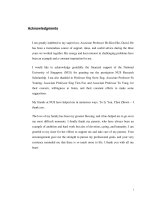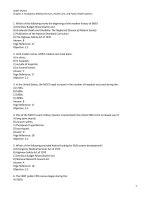Business statistics a decision making approach 6th edition ch09ppln
Bạn đang xem bản rút gọn của tài liệu. Xem và tải ngay bản đầy đủ của tài liệu tại đây (284.89 KB, 46 trang )
Business Statistics:
A Decision-Making Approach
6th Edition
Chapter 9
Estimation and Hypothesis
Testing for Two Population
Parameters
Business Statistics: A Decision-Making Approach, 6e © 2010 PrenticeHall, Inc.
Chap 9-1
Chapter Goals
After completing this chapter, you should be
able to:
Test hypotheses or form interval estimates for
two independent population means
Standard deviations known
Standard deviations unknown
two means from paired samples
the difference between two population
proportions
Business Statistics: A Decision-Making Approach, 6e © 2010 PrenticeHall, Inc.
Chap 9-2
Estimation for Two
Populations
Estimating two
population values
Population
means,
independent
samples
Paired
samples
Population
proportions
Examples:
Group 1 vs.
independent
Group 2
Same group
before vs. after
treatment
Business Statistics: A Decision-Making Approach, 6e © 2010 PrenticeHall, Inc.
Proportion 1 vs.
Proportion 2
Chap 9-3
Difference Between Two
Means
Population means,
independent
samples
*
σ1 and σ2 known
σ1 and σ2 unknown,
n1 and n2 30
Goal: Form a confidence
interval for the difference
between two population
means, μ1 – μ2
The point estimate for the
difference is
σ1 and σ2 unknown,
n1 or n2 < 30
Business Statistics: A Decision-Making Approach, 6e © 2010 PrenticeHall, Inc.
x1 – x2
Chap 9-4
Independent Samples
Population means,
independent
samples
*
σ1 and σ2 known
σ1 and σ2 unknown,
n1 and n2 30
σ1 and σ2 unknown,
n1 or n2 < 30
Different data sources
Unrelated
Independent
Sample selected from
one population has no
effect on the sample
selected from the other
population
Use the difference between 2
sample means
Use z test or pooled variance
t test
Business Statistics: A Decision-Making Approach, 6e © 2010 PrenticeHall, Inc.
Chap 9-5
σ1 and σ2 known
Population means,
independent
samples
σ1 and σ2 known
σ1 and σ2 unknown,
n1 and n2 30
σ1 and σ2 unknown,
n1 or n2 < 30
Assumptions:
*
Samples are randomly and
independently drawn
population distributions are
normal or both sample sizes
are 30
Population standard
deviations are known
Business Statistics: A Decision-Making Approach, 6e © 2010 PrenticeHall, Inc.
Chap 9-6
σ1 and σ2 known
(continued)
Population means,
independent
samples
σ1 and σ2 known
When σ1 and σ2 are known and
both populations are normal or
both sample sizes are at least 30,
the test statistic is a z-value…
*
…and the standard error of
x1 – x2 is
σ1 and σ2 unknown,
n1 and n2 30
σ1 and σ2 unknown,
n1 or n2 < 30
Business Statistics: A Decision-Making Approach, 6e © 2010 PrenticeHall, Inc.
σ x1 x 2
2
1
2
σ
σ2
n1
n2
Chap 9-7
σ1 and σ2 known
(continued)
Population means,
independent
samples
σ1 and σ2 known
σ1 and σ2 unknown,
n1 and n2 30
The confidence interval for
μ1 – μ2 is:
*
x
1
x 2 z /2
2
1
2
σ
σ2
n1
n2
σ1 and σ2 unknown,
n1 or n2 < 30
Business Statistics: A Decision-Making Approach, 6e © 2010 PrenticeHall, Inc.
Chap 9-8
σ1 and σ2 unknown, large
samples
Assumptions:
Population means,
independent
samples
Samples are randomly and
independently drawn
σ1 and σ2 known
σ1 and σ2 unknown,
n1 and n2 30
*
both sample sizes
are 30
Population standard
deviations are unknown
σ1 and σ2 unknown,
n1 or n2 < 30
Business Statistics: A Decision-Making Approach, 6e © 2010 PrenticeHall, Inc.
Chap 9-9
σ1 and σ2 unknown, large
samples
(continued)
Population means,
independent
samples
Forming interval
estimates:
use sample standard
deviation s to estimate σ
σ1 and σ2 known
σ1 and σ2 unknown,
n1 and n2 30
*
the test statistic is a z value
σ1 and σ2 unknown,
n1 or n2 < 30
Business Statistics: A Decision-Making Approach, 6e © 2010 PrenticeHall, Inc.
Chap 9-10
σ1 and σ2 unknown, large
samples
(continued)
Population means,
independent
samples
The confidence interval for
μ1 – μ2 is:
σ1 and σ2 known
x
σ and σ unknown, *
1
1
2
n1 and n2 30
x 2 z /2
2
1
2
s
s2
n1 n2
σ1 and σ2 unknown,
n1 or n2 < 30
Business Statistics: A Decision-Making Approach, 6e © 2010 PrenticeHall, Inc.
Chap 9-11
σ1 and σ2 unknown, small
samples
Population means,
independent
samples
Assumptions:
populations are normally
distributed
σ1 and σ2 known
the populations have equal
variances
σ1 and σ2 unknown,
n1 and n2 30
σ1 and σ2 unknown,
n1 or n2 < 30
samples are independent
*
Business Statistics: A Decision-Making Approach, 6e © 2010 PrenticeHall, Inc.
Chap 9-12
σ1 and σ2 unknown, small
samples
(continued)
Forming interval
estimates:
Population means,
independent
samples
The population variances
are assumed equal, so use
the two sample standard
deviations and pool them to
estimate σ
σ1 and σ2 known
σ1 and σ2 unknown,
n1 and n2 30
σ1 and σ2 unknown,
n1 or n2 < 30
*
the test statistic is a t value
with (n1 + n2 – 2) degrees
of freedom
Business Statistics: A Decision-Making Approach, 6e © 2010 PrenticeHall, Inc.
Chap 9-13
σ1 and σ2 unknown, small
samples
(continued)
The pooled standard
deviation is
Population means,
independent
samples
σ1 and σ2 known
σ1 and σ2 unknown,
n1 and n2 30
σ1 and σ2 unknown,
n1 or n2 < 30
sp
n1 1s
n2 1s2
n1 n2 2
2
1
2
*
Business Statistics: A Decision-Making Approach, 6e © 2010 PrenticeHall, Inc.
Chap 9-14
σ1 and σ2 unknown, small
samples
(continued)
The confidence interval for
μ1 – μ2 is:
Population means,
independent
samples
x
σ1 and σ2 known
σ1 and σ2 unknown,
n1 and n2 30
σ1 and σ2 unknown,
n1 or n2 < 30
1
x 2 t /2 sp
1 1
n1 n2
Where t/2 has (n1 + n2 – 2) d.f.,
*
and
Business Statistics: A Decision-Making Approach, 6e © 2010 PrenticeHall, Inc.
sp
n1 1s12 n2 1s2 2
n1 n2 2
Chap 9-15
Paired Samples
Tests Means of 2 Related Populations
Paired
samples
Paired or matched samples
Repeated measures (before/after)
Use difference between paired values:
d = x 1 - x2
Eliminates Variation Among Subjects
Assumptions:
Both Populations Are Normally Distributed
Or, if Not Normal, use large samples
Business Statistics: A Decision-Making Approach, 6e © 2010 PrenticeHall, Inc.
Chap 9-16
Paired Differences
The ith paired difference is di , where
Paired
samples
di = x1i - x2i
The point estimate for
the population mean
paired difference is d :
The sample standard
deviation is
n
d
i
d
i 1
n
n
sd
2
(d
d
)
i
i1
n 1
n is the number of pairs in the paired sample
Business Statistics: A Decision-Making Approach, 6e © 2010 PrenticeHall, Inc.
Chap 9-17
Paired Differences
(continued)
Paired
samples
The confidence interval for d is
d t /2
sd
n
n
Where t/2 has
n - 1 d.f. and sd is:
sd
2
(d
d
)
i
i1
n 1
n is the number of pairs in the paired sample
Business Statistics: A Decision-Making Approach, 6e © 2010 PrenticeHall, Inc.
Chap 9-18
Hypothesis Tests for the
Difference Between Two Means
Testing Hypotheses about μ1 – μ2
Use the same situations discussed already:
Standard deviations known or unknown
Sample sizes 30 or not 30
Business Statistics: A Decision-Making Approach, 6e © 2010 PrenticeHall, Inc.
Chap 9-19
Hypothesis Tests for
Two Population Proportions
Two Population Means, Independent Samples
Lower tail test:
Upper tail test:
Two-tailed test:
H0: μ1 μ2
HA: μ1 < μ2
H0: μ1 ≤ μ2
HA: μ1 > μ2
H0: μ1 = μ2
HA: μ1 ≠ μ2
i.e.,
i.e.,
i.e.,
H0: μ1 – μ2 0
HA: μ1 – μ2 < 0
H0: μ1 – μ2 ≤ 0
HA: μ1 – μ2 > 0
H0: μ1 – μ2 = 0
HA: μ1 – μ2 ≠ 0
Business Statistics: A Decision-Making Approach, 6e © 2010 PrenticeHall, Inc.
Chap 9-20
Hypothesis tests for μ1 – μ2
Population means, independent samples
σ1 and σ2 known
Use a z test statistic
σ1 and σ2 unknown,
n1 and n2 30
Use s to estimate unknown
σ , approximate with a z
test statistic
σ1 and σ2 unknown,
n1 or n2 < 30
Use s to estimate unknown
σ , use a t test statistic and
pooled standard deviation
Business Statistics: A Decision-Making Approach, 6e © 2010 PrenticeHall, Inc.
Chap 9-21
σ1 and σ2 known
Population means,
independent
samples
σ1 and σ2 known
The test statistic for
μ1 – μ2 is:
*
x
z
σ1 and σ2 unknown,
n1 and n2 30
1
x 2 μ1 μ2
2
1
2
σ
σ2
n1
n2
σ1 and σ2 unknown,
n1 or n2 < 30
Business Statistics: A Decision-Making Approach, 6e © 2010 PrenticeHall, Inc.
Chap 9-22
σ1 and σ2 unknown, large
samples
Population means,
independent
samples
The test statistic for
μ1 – μ2 is:
σ1 and σ2 known
σ1 and σ2 unknown,
n1 and n2 30
*
x
z
1
x 2 μ1 μ2
2
1
2
s
s2
n1 n2
σ1 and σ2 unknown,
n1 or n2 < 30
Business Statistics: A Decision-Making Approach, 6e © 2010 PrenticeHall, Inc.
Chap 9-23
σ1 and σ2 unknown, small
samples
The test statistic for
μ1 – μ2 is:
Population means,
independent
samples
x
z
σ1 and σ2 known
σ1 and σ2 unknown,
n1 and n2 30
σ1 and σ2 unknown,
n1 or n2 < 30
*
1
x 2 μ1 μ2
1 1
sp
n1 n2
Where t/2 has (n1 + n2 – 2) d.f.,
and
Business Statistics: A Decision-Making Approach, 6e © 2010 PrenticeHall, Inc.
sp
n1 1s12 n2 1s2 2
n1 n2 2
Chap 9-24
Hypothesis tests for μ1 – μ2
Two Population Means, Independent Samples
Lower tail test:
Upper tail test:
Two-tailed test:
H0: μ1 – μ2 0
HA: μ1 – μ2 < 0
H0: μ1 – μ2 ≤ 0
HA: μ1 – μ2 > 0
H0: μ1 – μ2 = 0
HA: μ1 – μ2 ≠ 0
-z
Reject H0 if z < -z
z
Reject H0 if z > z
Business Statistics: A Decision-Making Approach, 6e © 2010 PrenticeHall, Inc.
/2
-z/2
/2
z/2
Reject H0 if z < -z/2
or
z > z/2
Chap 9-25









